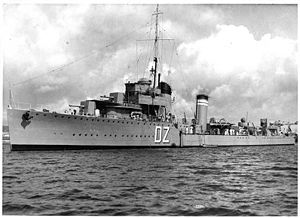Spanish destroyer José Luis Díez

Destroyer José Luis Diez
|
|
| History | |
|---|---|
|
|
|
| Name: | José Luis Díez |
| Namesake: | José Luis Díez y Pérez Muñoz |
| Builder: | SECN, Naval Dockyard, Cartagena, Spain |
| Completed: | 1929 |
| Commissioned: | 1929 |
| Decommissioned: | 1965 |
| Identification: | JD |
| Nickname(s): | Pepe el del puerto |
| Fate: | Scrapped in 1965 |
| General characteristics | |
| Class and type: | Churruca-class destroyer |
| Displacement: | 1,650 tons (normal); 2,067 tons (maximum) |
| Length: | 101 m (331 ft 4 in) |
| Beam: | 9.6 m (31 ft 6 in) |
| Height: | 6.02 m (19 ft 9 in) |
| Draught: | 3.3 m (10 ft 10 in) |
| Installed power: | |
| Propulsion: | 2 Parsons turbines |
| Speed: | 36 knots (67 km/h) |
| Range: |
|
| Complement: | 160 |
| Armament: |
|
José Luis Díez was a Churruca-class destroyer in the Spanish Republican Navy. She took part in the Spanish Civil War on the government side.
She was named after Teniente de Navío José Luis Díez y Pérez Muñoz.
The ship sailed into Biscay in 1936 and was anchored off Santurce for some time. She received the nickname Pepe el del puerto ("Joe of the harbor"), for her perceived inactivity.
On 20 April 1937, she was involved in a friendly fire incident when her anti-aircraft guns shot down Felipe del Río's Polikarpov I-15. The gunners mistook the aircraft for a German fighter.
On 31 May of the same year, the Police and the Marina de Guerra Auxiliar de Euzkadi took control of José Luis Díez and Císcar. At the request of the Republican government, the ships embarked more than 200 sailors of the auxiliary Navy from Euzkadi to replace their original crews, who had been deemed untrustworthy. The ships were eventually returned to their original crews.
On 10 June 1937, Císcar, under the command of Alférez de Navío Juan Antonio Castro and José Luis Díez commanded by teniente de navío Evaristo Lopez engaged the cruiser Almirante Cervera (capitán de navío Manuel Moreu). The result was inconclusive.
José Luis Díez and Císcar left Bilbao on 15 June 1937, heading for France. They were loaded with refugees and several civilian and military personalities, shortly before the Nationalists entered Bilbao. Both ships went on to Santander, and after its fall, to Gijon. José Luis Díez then took refuge in Falmouth, England where, among others, the commander, the engine room chief and the navigator deserted. Subsequently, the destroyer sailed to Le Havre, France.
...
Wikipedia
